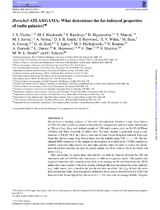Herschel-ATLAS/GAMA: What determines the far-infrared properties of radio galaxies?
Abstract
We perform a stacking analysis of Herschel Astrophysical Terahertz Large Area Survey
(H-ATLAS) data in order to obtain isothermal dust temperatures and rest-frame luminosities
at 250 µm (L250), for a well-defined sample of 1599 radio sources over the H-ATLAS Phase
1/Galaxy and Mass Assembly (GAMA) area. The radio sample is generated using a combination
of NRAO VLA Sky Survey data and K-band United Kingdom Infrared Telescope
Deep Sky Survey–Large Area Survey data, over the redshift range 0.01 <z< 0.8. The farinfrared
(FIR) properties of the sample are investigated as a function of 1.4-GHz luminosity,
redshift, projected radio-source size and radio spectral index. In order to search for stellarmass-dependent
relations, we split the parent sample into those sources which are below and
above 1.5L∗
K.
After correcting for stellar mass and redshift, we find no relation between the 250-µm
luminosity and the 1.4-GHz radio luminosity of radio active galactic nuclei. This implies that
a galaxy’s nominal radio luminosity has little or no bearing on the star formation rate (SFR)
and/or dust mass content of the host system, although this does not mean that other variables
(e.g. radio source size) related to the jets do not have an effect. The L250 of both the radio
detected and non-radio-detected galaxies (defined as those sources not detected at 1.4 GHz but
detected in the Sloan Digital Sky Survey with r < 22) rises with increasing redshift. Compact
radio sources (<30 kpc) are associated with higher 250 µm luminosities and dust temperatures
than their more extended (>30 kpc) counterparts. The higher dust temperature suggests that
this may be attributed to enhanced SFRs in compact radio galaxies, but whether this is directly
or indirectly due to radio activity (e.g. jet-induced or merger-driven star formation) is as yet
unknown.
For matched samples in LK and g
–r
, sub-1.5L∗
K and super-1.5L∗
K radio-detected galaxies
have 0.89±0.18 and 0.49±0.12 times the 250μm luminosity of their non-radio-detected
counterparts. Thus, while no difference in L250 is observed in sub-1.5L∗
K radio-detected
galaxies, a strong deficit is observed in super-1.5L∗
K radio-detected galaxies. We explain
these results in terms of the hotter, denser and richer halo environments massive radio galaxies
maintain and are embedded in. These environments are expected to quench the cold gas and dust
supply needed for further star formation and therefore dust production. Our results indicate
that all massive radio galaxies (>1.5L∗
K) may have systematically lower FIR luminosities
(∼25 per cent) than their colour-matched non-radio-detected counterparts. Finally, no relation
between radio spectral index and L250 is found for the subset of 1.4-GHz radio sources with
detections at 330 MHz.

